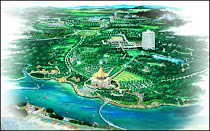Below are some of the phrases taken from "The official Kuching guide 2007" prepared by Wayne Tarman & Mike Reed, sponsored by Sarawak Tourism Board.
"Like all towns and cities in Borneo, the focal point of Kuching, and the reason for its existence, is the river. Hiring a “sampan” to meander slowly up and down the Sarawak River is the best way to get your first impression of Kuching, and a real bargain. It’s good during the day, bliss at sunset and a truly one-off experience at night. From the river you will see picturesque Malay villages (kampungs), a golden-domed mosque, a Victorian fort, a whole street of 19th century Chinese shophouses and an imposing wooden-roofed palace, all set against a background of distant mountains."
"The Waterfront offers excellent views of the Astana, Fort Margherita and the Malay kampungs which line the north bank of the river, but at night-time it really comes alive; it seems like half of Kuching is out meeting friends, watching a show, or just taking the air. "
Obviously, the quality of the city can be summed up as follow:
- the villages (kampung) line the north bank of the river, opposite the city centre.
- the river as the primary icon of the city
- waterway transport - the sampan (small wooden boat)
- picturesque setting made up from these features - distant mountains, historic buildings, villages, sunset and the river.
So the question I want everyone to ask is the modern development as shown in
this post - the oversized State Assembly building, arced pedestrian bridge and wide boulevards to replace the forested water edge, villages and the surrounds of the historic sites appropriate ?















